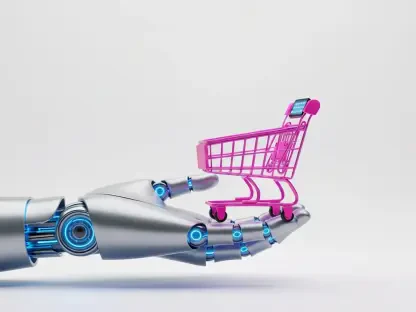Retail expert Zainab Hussain shares strategic insights from her extensive experience in e-commerce and operations management, highlighting the intricate dance between tariffs, supply chains, and consumer markets. As U.S. retailers navigate complex challenges posed by recent tariff hikes on Chinese goods, Zainab deciphers the impacts and potential mitigation strategies for businesses large and small.
Can you explain how Trump’s tariffs are specifically affecting U.S. retailers?
The tariffs are creating an environment of uncertainty and difficulty for U.S. retailers. They’re forced to evaluate the balance between incurring steep import costs and the risk of not meeting consumer demand. Many retailers are canceling shipments to avoid the tariffs, which could lead to empty shelves and disrupt the predictability of supply chains that were already under strain during the COVID era.
How has the 145% tariff on Chinese goods impacted the decision-making process for retailers when placing orders?
With such high tariffs, retailers are wary of placing large orders due to the massive financial burden it imposes. This unpredictability leads to a paralysis in decision-making as businesses have to consider the risk of either overstocking or being underprepared. They are now more cautious, using revised models and analytics to forecast demand and manage inventory levels while also exploring alternative sourcing strategies.
Why are certain products like footwear, clothing, and toys more vulnerable to shortages due to these tariffs?
These products are heavily reliant on Chinese manufacturing because of the well-established, cost-effective supply chains built over years. Changing this setup is not quick or simple. So when tariffs spike, the cost advantage of manufacturing in China diminishes, leading to potential shortages as retailers find it financially unviable to pay excessive tariffs on these traditionally low-margin items.
What effect have these tariffs had on the import rates at ports like the Port of Los Angeles?
There’s been a noticeable decline in import rates, with a reported 33% drop in cargo ships arriving at key ports like the Port of Los Angeles. This reduction is significant enough to hint at broader supply chain delays and bottlenecks, as fewer goods arriving means longer turnaround times in ports and the potential for congestion as stock levels adjust to these new challenges.
How are the tariffs affecting smaller businesses compared to larger retailers like Target?
Smaller businesses often lack the financial resources to absorb such increased costs. Unlike larger companies that might have the capital to bring in shipments ahead of tariff announcements or negotiate better deals, smaller entities face direct hits to their operating costs. As a result, they may have to raise prices, risking reduced consumer demand and profitability, or worse, their very survival.
Could you elaborate on the economic impact these tariffs are having on consumer pricing?
The tariffs inevitably lead to increased consumer prices as retailers attempt to pass on some of the additional costs. Many businesses risk operating at a loss to remain competitive. For items like clothing and electronics where the production cost difference is highly noticeable, the price increase can significantly affect consumer buying behavior, potentially reducing sales volumes.
What specific challenges are businesses facing in terms of logistics and supply chain management due to these tariffs?
Businesses are finding logistical planning more complicated, needing to constantly adapt to changing tariffs and costs. This can cause delays, increased lead times, and the need for rerouting products to less congested ports. The lack of predictability also adds pressure on inventory management, requiring innovative solutions to maintain efficient operations.
How might these tariffs impact holiday and back-to-school shopping seasons specifically?
These peak seasons generally require precise and early planning from retailers. If tariffs persist, retailers might see reduced inventory for crucial shopping periods like holidays and back-to-school, where demand traditionally spikes. This could lead to disappointed consumers and missed sales opportunities, affecting annual revenue figures significantly.
Are there any exceptions to the tariff on certain goods, and how do they affect businesses?
Yes, certain exceptions apply, notably for electronics and pharmaceuticals, which have lower tariff rates. However, this can lead to strategic shifts where businesses focus more heavily on these items, attempting to circumvent heavier tariff burdens. It encourages diversification but also requires rapid adaptation, which may be challenging for some businesses.
What are the potential long-term consequences if these tariffs continue?
Persistent tariffs could force a revaluation of global supply chain strategies and possibly a more significant shift away from reliance on Chinese manufacturing. Companies may seek out alternative production locations, domesticate supply chains, or even explore new markets. Long-term effects include potential price adjustments, shifts in trade partnerships, and a broader impact on global economic dynamics.
How has the government responded to the warnings from retailers about potential product shortages?
While there have been some discussions and acknowledgments of the issue, significant actions have yet to be taken. Although the government has indicated it might consider reducing tariffs, as of now, no formal measures have been implemented, leaving the situation in a state of apprehension for many retailers.
What are some possible solutions retailers are exploring to mitigate the impact of these tariffs?
Retailers are considering several strategies like sourcing from different countries, renegotiating supplier contracts, or even diversifying their product lines to include tariff-exempt items. They’re also investing in supply chain innovations and technology to improve efficiency and reduce costs, attempting to absorb the tariff’s impact proactively.
How do these tariff-related challenges compare to those experienced during the COVID era?
While both scenarios involve significant supply chain disruptions, the COVID era was marked by global uncertainty and sporadic shutdowns affecting all markets equally. The tariff situation, however, introduces a layer of financial intricacies specific to U.S.-China trade, with lasting economic implications influencing trade policies and cost structures more directly.
Could you discuss how the tariffs might affect the ground transportation sector and the trucking industry?
The trucking industry faces potential disruptions too, as cargo volumes might fluctuate unpredictably with changing tariffs. If container traffic at ports decreases, this affects drivers’ workloads and earnings. Routes may need adjusting to account for changing distribution hubs, which further influences freight rates and could lead to fewer job opportunities and industry instability.
What is the timeline for recovery once and if the tariffs are reduced, according to industry experts?
Recovery timelines suggest an eight-week delay before any significant rebound in volume and efficiency could occur. Full recovery might extend well into the year or beyond, as supply chains recalibrate to previous patterns. The adaptation phase will require careful planning and strategic execution to manage the pent-up demand and restore balance to affected industries.









